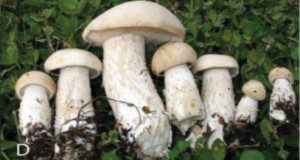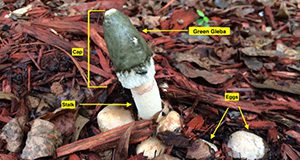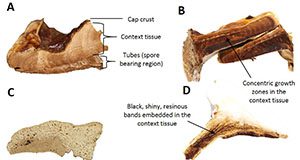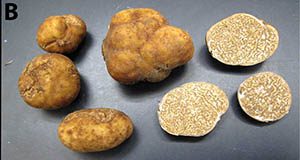The “bird’s nest” fungi (Nidulariaceae) are charismatic mushrooms that look like small nests containing multiple tiny eggs. Because the ecological role of bird’s nest fungi is to decompose wood, they are extremely common in disturbed areas with plant debris and mulch, such as trails and backyard gardens. These fungi tend to grow in large clusters, so it is common to see ten to a hundred of these “nests” at once. Bird’s nest fungi are not considered dangerous to plants, animals, or humans. This new 3-page publication of the UF/IFAS Plant Pathology Department was written by Nattapol Kraisitudomsook and Matthew E. Smith.
https://edis.ifas.ufl.edu/pp361
Tag: Matthew E. Smith
Chicken of the Woods (Laetiporus sulphureus species complex)
Species in the Laetiporus sulphureus species complex, also known as “chicken of the woods” mushrooms, are wood-decay fungi that cause brown rot within the heartwood of their tree hosts. The common name “chicken of the woods” is given to some species in this group because they are tasty edible mushrooms. Several Laetiporus species have been harvested to use as food colorants, to dye natural products such as wool, and for human consumption. This new 4-page publication of the UF/IFAS Plant Pathology Department, written by Brianna Benitez, Claudia A. Paez, Matthew E. Smith, and Jason A. Smith, describes these fungi as well as their ecology, management, and potential edibility.
https://edis.ifas.ufl.edu/pp358
Macrocybe titans: The Mushroom Giant of the Western Hemisphere
The aptly named Macrocybe titans, meaning “giant head,” is the largest known gilled mushroom in the Western Hemisphere. This species was originally described from Florida but can be found across the southeastern United States as well as the Caribbean, Central America, and parts of South America. These mushrooms are often found in clusters with the caps growing as large as 3 ft wide and 1–1.5 ft tall! This species was first discovered in Gainesville, Florida, and is generally found near buildings or roads. This new three-page publication of the UF/IFAS Plant Pathology Department describes these giant mushrooms, their discovery, and where to find them. Written by Elena Karlsen-Ayala and Matthew E. Smith.
https://edis.ifas.ufl.edu/pp356
Stinkhorn Mushrooms (Agaricomycetes: Phallales: Phallaceae)
Stinkhorn mushrooms are commonly found in Florida home gardens and along the Gulf Coast, and are known for their offensive, rotting odor. This 5-page document profiles the morphology, ecology, phenolology, toxicology, and treatment of this mushroom. Written by Eleanor Phillips, Jennifer L. Gillett-Kaufman, and Matthew E. Smith and published by the UF/IFAS Plant Pathology Department, December 2018.
http://edis.ifas.ufl.edu/pp345
The Laccate Ganoderma of the Southeastern United States: A Cosmopolitan and Important Genus of Wood Decay Fungi
Ganoderma Karst. is a large and diverse genus of wood decay fungi that can rot the roots and/or lower trunk of many tree species. There are several laccate (varnished or polished) Ganoderma species that are found in the southeastern United States and this six-page fact sheet provides an overview of the different species. Written by Andrew L. Loyd, Jason A. Smith, Brantlee S. Richter, Robert A. Blanchette, and Matthew E. Smith and published by the Plant Pathology Department.
http://edis.ifas.ufl.edu/pp333
The Pecan Truffle (Tuber lyonii): A Gourmet Truffle Native to the Southeastern United States
A truffle is a round, knobby, or lobed mushroom fruiting body that forms below ground. The “pecan truffle” (Tuber lyonii) is an edible truffle species, native to eastern North America. This fungus lives in a mutually beneficial relationship with the roots of some trees, including species of oak, hazelnut, and hickory trees, as well as the cultivated pecan tree. This four-page fact sheet describes the pecan truffle, its economic and culinary significance, morphology, and phenology and distribution. Written by Arthur C. Grupe II, Timothy Brenneman, Gregory Bonito, and Matthew E. Smith and published by the Plant Pathology Department.
http://edis.ifas.ufl.edu/pp330
The Green-Spore Poison Parasol Mushroom,Chlorophyllum molybdites
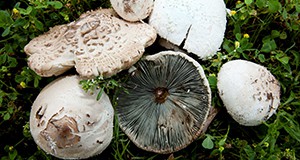
The “false parasol” or “green-spored parasol” mushroom (Chlorophyllum molybdites) is a poisonous mushroom that is the most common cause of mushroom poisoning in the United States. This mushroom is widely distributed throughout Florida and the southeastern United States. It commonly creates a complete or incomplete “fairy ring” in lawns, grassy areas, and open woods. When mature, the green-spored parasol mushroom has a large cap, a ring around its stem, and a greenish color on the underside of its gills. This four-page fact sheet describes the morphology, ecology, and distribution of the green-spored mushroom as well as its toxicology and how to treat poisoning from this mushroom. Written by Lisbeth Espinoza and Matthew E. Smith, and published by the Plant Pathology department.
http://edis.ifas.ufl.edu/pp324


